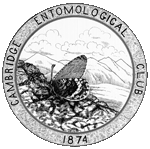
| January 2008: Psyche has a new publisher, Hindawi Publishing, and is accepting submissions |
Article beginning on page 14.
Psyche 11:14, 1904.
Full text (searchable PDF)
Durable link: http://psyche.entclub.org/11/11-014.html
The following unprocessed text is extracted from the PDF file, and is likely to be both incomplete and full of errors. Please consult the PDF file for the complete article.
14
PSYCHE [February
I
ORMAL SPECIMEN OF BEMBJDIUM SCUDDERL
1
BY ROLAND HAYWARD, MILTOX, MASS.
While examining a number of examples of Bembidwm seudderi recently received from Mr, H. F. Wickham from Humboldt Lake. Nev., I noticed a curious monstrosity in a specimen of that species which seems of sufficient interest to publish.
As is well known the dorsal punctures of the elytra are very constant both in number and position in our numerous species of Bembidium, and afford very use- ful characters for the subdivision of the genus into groups. With few exceptions they are two in number and are situated either on the third interval or the third stria. In two of our groups, one containing ZmIgatum, and the other scntistriafum and constricticolle, they are placed in irregular rows on all the intervals. In two others they are three in number, being situated on the third stria in that of which rkksecke~is the type, while in the group containing hewhaw& consimik, scudderi and Aageni they are on the third interval. '
In the specimen before me there are on the third interval of the left elytron die abnormal number of ‰âÂo punctures, while on that of the right there are three, placed as in normal specimens. On the left elytron the first puncture is in normal position, the second, however, is situated much nearer the base, while between it and the one nearest the apex, which is situated as on the right elytron, is inter- polated an additional puncture, placed nearly midway between the second and fourth, but slightly nearer the latter. A curious fact to be observed is that only the first, second and fourth punctures are setigerous, the third showing no trace of seta. The set= arising from the three dorsal punctures of the right elytron are also distinct.
QE course the case is a monstrosity only, showing as it does, in a small way, a deviation from bilateral symmetry, but it seems interesting that it should occur in a member of a group in which the normal number of dorsal punctures is in excess of that occurring in the vast majority of our species, and may possibly indicate an inherited tendency toward an increase in their number. The group as a whole is confined to the western portions of our country and to Mexico. Only one species, B. wnsMe, occurs as far east as Nebraska, extend- ing westward to Utah, while /ims/nm~i and scudderi occur in the region between western Wyoming and California.
All three are found, as I learn from corre- spondents, on alkaline mud along the shores of s d ponds. Of the
habits of kageni nothing is known.
I
i
I
================================================================================
Volume 11 table of contents